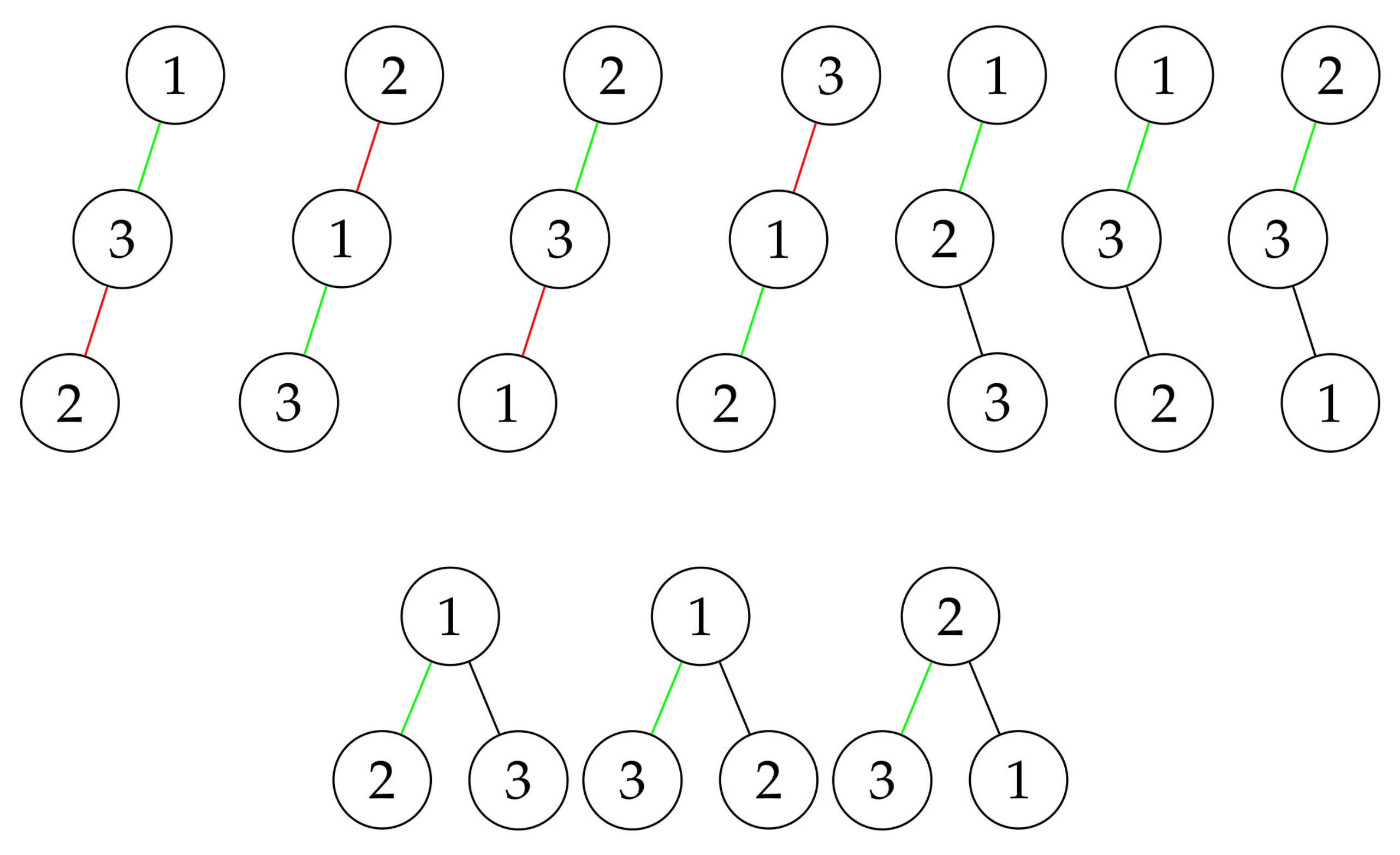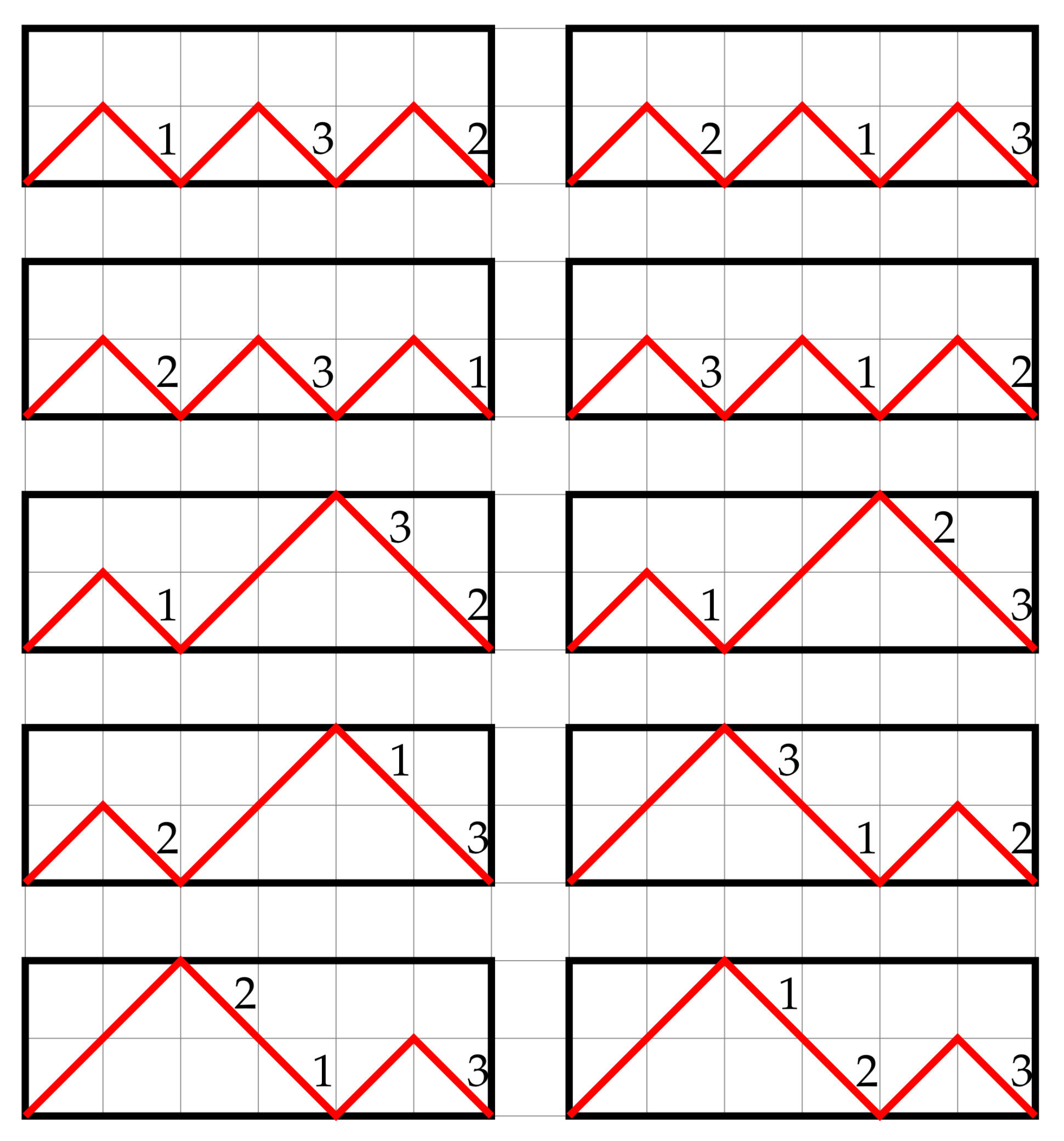Euler–Catalan’s Number Triangle and Its Application
Abstract
1. Introduction
2. Combinatorial Objects
3. Main Results
4. Conclusions
Author Contributions
Funding
Acknowledgments
Conflicts of Interest
References
- Knuth, D.E. The Art of Computer Programming, Volume 4A: Combinatorial Algorithms; Addison-Wesley: Boston, MA, USA, 2011. [Google Scholar]
- Graham, R.L.; Knuth, D.E.; Patashnik, O. Concrete Mathematics; Addison-Wesley: Boston, MA, USA, 1994. [Google Scholar]
- Banderier, C.; Bousquet-Melou, M.; Denise, A.; Flajolet, P.; Gardy, D.; Gouyou-Beauchamps, D. Generating functions for generating trees. Discret. Math. 2002, 246, 29–55. [Google Scholar] [CrossRef]
- Mansour, T.; Shattuck, M.; Wagner, S. Enumerating set partitions by the number of positions between adjacent occurrences of a letter. Appl. Anal. Discret. Math. 2010, 4, 284–308. [Google Scholar]
- Drmota, M. Embedded trees and the support of the ISE. Eur. J. Combin. 2013, 34, 123–137. [Google Scholar] [CrossRef] [PubMed][Green Version]
- Srivastava, H.M.; Chaudhary, M.P. Some relationships between g-product identities, combinatorial partition identities and continued-fraction identities. Adv. Stud. Contemp. Math. 2015, 25, 265–272. [Google Scholar]
- Mansour, T.; Shattuck, M. New refined enumerations of set partitions related to sorting. J. Differ. Equ. Appl. 2018, 24, 1588–1603. [Google Scholar] [CrossRef]
- Bayad, A.; Simsek, Y.; Srivastava, H.M. Some array type polynomials associated with special numbers and polynomials. Appl. Math. Comput. 2014, 244, 149–157. [Google Scholar] [CrossRef]
- Cakic, N.P.; El-Desouky, B.S.; Milovanovic, G.V. Explicit formulas and combinatorial identities for generalized Stirling numbers. Mediterr. J. Math. 2013, 10, 57–72. [Google Scholar] [CrossRef]
- Gould, H.W. A new symmetrical combinatorial ldentity. J. Combin. Theory Ser. A 1972, 13, 278–286. [Google Scholar] [CrossRef]
- Mansour, T.; Shattuck, M. A generalized class of restricted Stirling and Lah numbers. Math. Slovaca 2018, 68, 727–740. [Google Scholar] [CrossRef]
- Simsek, Y. New families of special numbers for computing negative order Euler numbers and related numbers and polynomials. Appl. Anal. Discret. Math. 2018, 12, 1–35. [Google Scholar] [CrossRef]
- Belov, A.Y. Linear recurrence equations on a tree. Math. Notes 2005, 78, 603–609. [Google Scholar] [CrossRef]
- Gessel, I.M.; Griffin, S.T.; Tewari, V. Labeled binary trees, subarrangements of the Catalan arrangements, and Schur positivity. Adv. Math. 2019, 356, 1–67. [Google Scholar] [CrossRef]
- Rubey, M.; Stump, C. FindStat—The combinatorial statistics database. Available online: http://www.findstat.org (accessed on 1 March 2020).
- Deutsch, E. Dyck path enumeration. Discret. Math. 1999, 204, 167–202. [Google Scholar] [CrossRef]
- Banderier, C.; Krattenthaler, C.; Krinik, A.; Kruchinin, D.; Kruchinin, V.; Nguyen, D.; Wallner, M. Explicit formulas for enumeration of lattice paths: Basketball and the kernel method. In Lattice Path Combinatorics and Applications; Springer: Cham, Switzerland, 2019; Volume 58, pp. 78–118. [Google Scholar]
- Sapounakis, A.; Tasoulas, I.; Tsikouras, P. Dyck path statistics. WSEAS Trans. Math. 2006, 5, 459–464. [Google Scholar]
- Labelle, J.; Yeh, Y.N. Generalized Dyck paths. Discret. Math. 1990, 82, 1–6. [Google Scholar] [CrossRef]
- Rukavicka, J. On generalized Dyck paths. Electron. J. Combin. 2011, 18, 1–3. [Google Scholar] [CrossRef]
- Cameron, N.T.; McLeod, J.E. Returns and hills on generalized Dyck paths. J. Integer Seq. 2016, 19, 1–28. [Google Scholar]
- Xu, R.; Yeh, Y.N.; Zhu, X. List colouring of graphs and generalized Dyck paths. Discret. Math. 2018, 341, 810–819. [Google Scholar] [CrossRef]
- Penaud, J.G.; Roques, O. Génération de chemins de Dyck à pics croissants. Discret. Math. 2002, 246, 255–267. [Google Scholar] [CrossRef]
- Manes, K.; Sapounakis, A.; Tasoulas, I.; Tsikouras, P. Recursive generation of k-ary trees. J. Integer Seq 2009, 12, 1–18. [Google Scholar]
- Sloane, N.J.A. The on-line encyclopedia of integer sequences. Available online: http://oeis.org (accessed on 1 March 2020).
- Stanley, R.P. Catalan Numbers; Cambridge University Press: New York, NY, USA, 2015. [Google Scholar]
- Kim, D.S.; Kim, T. A new approach to Catalan numbers using differential equations. Russ. J. Math. Phys. 2017, 24, 465–475. [Google Scholar] [CrossRef]
- Eum, I.S. A congruence relation of the Catalan–Mersenne numbers. Indian J. Pure Appl. Math. 2018, 49, 521–526. [Google Scholar] [CrossRef]
- Bidkhori, H.; Sullivant, S. Eulerian–Catalan numbers. Electron. J. Combin. 2011, 18, 1–10. [Google Scholar] [CrossRef]
- Kim, T.; Kim, D.S. Some identities of Catalan-Daehee polynomials arising from umbral calculus. Appl. Comput. Math. 2017, 16, 177–189. [Google Scholar]
- Kim, T.; Kim, D.S. Differential equations associated with Catalan-Daehee numbers and their applications. Rev. R. Acad. Cienc. Exactas Fis. Nat. Ser. A Mat. RACSAM 2017, 111, 1071–1081. [Google Scholar] [CrossRef]
- Dolgy, D.V.; Jang, G.W.; Kim, D.S.; Kim, T. Explicit expressions for Catalan-Daehee numbers. Proc. Jangjeon Math. Soc. 2017, 20, 1–9. [Google Scholar]
- Mariconda, C.; Tonolo, A. Stirling numbers and Eulerian numbers. In Discrete Calculus; Springer: Cham, Switzerland, 2016; pp. 105–151. [Google Scholar]
- Chen, B.F.; Ghorbani, E.; Wong, K.B. Cyclic decomposition of k-permutations and eigenvalues of the arrangement graphs. Electron. J. Combin. 2013, 20, 1–18. [Google Scholar] [CrossRef]
- Tanimoto, S. An operator on permutations and its application to Eulerian numbers. Eur. J. Combin. 2001, 22, 569–576. [Google Scholar] [CrossRef]
- Kruchinin, V.V.; Kruchinin, D.V. Composita and its properties. J. Anal. Number Theory 2014, 2, 37–44. [Google Scholar]
- Kruchinin, D.V.; Kruchinin, V.V. A method for obtaining generating functions for central coefficients of triangles. J. Integer Seq. 2012, 15, 1–10. [Google Scholar]


| 1 | 2 | 3 | 4 | 5 | 6 | 7 | 8 | 9 | 10 | |
|---|---|---|---|---|---|---|---|---|---|---|
| 1 | 1 | |||||||||
| 2 | 1 | 1 | ||||||||
| 3 | 2 | 2 | 1 | |||||||
| 4 | 5 | 5 | 3 | 1 | ||||||
| 5 | 14 | 14 | 9 | 4 | 1 | |||||
| 6 | 42 | 42 | 28 | 14 | 5 | 1 | ||||
| 7 | 132 | 132 | 90 | 48 | 20 | 6 | 1 | |||
| 8 | 429 | 429 | 297 | 165 | 75 | 27 | 7 | 1 | ||
| 9 | 1430 | 1430 | 1001 | 572 | 275 | 110 | 35 | 8 | 1 | |
| 10 | 4862 | 4862 | 3432 | 2002 | 1001 | 429 | 154 | 44 | 9 | 1 |
| 0 | 1 | 2 | 3 | 4 | 5 | 6 | 7 | 8 | 9 | |
|---|---|---|---|---|---|---|---|---|---|---|
| 0 | 1 | |||||||||
| 1 | 1 | 0 | ||||||||
| 2 | 1 | 1 | 0 | |||||||
| 3 | 1 | 4 | 1 | 0 | ||||||
| 4 | 1 | 11 | 11 | 1 | 0 | |||||
| 5 | 1 | 26 | 66 | 26 | 1 | 0 | ||||
| 6 | 1 | 57 | 302 | 302 | 57 | 1 | 0 | |||
| 7 | 1 | 120 | 1191 | 2416 | 1191 | 120 | 1 | 0 | ||
| 8 | 1 | 247 | 4293 | 15,619 | 15,619 | 4293 | 247 | 1 | 0 | |
| 9 | 1 | 502 | 14,608 | 88,234 | 156,190 | 88,234 | 14,608 | 502 | 1 | 0 |
| 0 | 1 | 2 | 3 | 4 | 5 | 6 | 7 | 8 | 9 | |
|---|---|---|---|---|---|---|---|---|---|---|
| 0 | 1 | |||||||||
| 1 | 1 | 1 | ||||||||
| 2 | 1 | 2 | 2 | |||||||
| 3 | 1 | 3 | 6 | 6 | ||||||
| 4 | 1 | 4 | 12 | 24 | 24 | |||||
| 5 | 1 | 5 | 20 | 60 | 120 | 120 | ||||
| 6 | 1 | 6 | 30 | 120 | 360 | 720 | 720 | |||
| 7 | 1 | 7 | 42 | 210 | 840 | 2520 | 5040 | 5040 | ||
| 8 | 1 | 8 | 56 | 336 | 1680 | 6720 | 20,160 | 40,320 | 40,320 | |
| 9 | 1 | 9 | 72 | 504 | 3024 | 15,120 | 60,480 | 181,440 | 362,880 | 362,880 |
| 0 | 1 | 2 | 3 | 4 | 5 | 6 | 7 | 8 | |
|---|---|---|---|---|---|---|---|---|---|
| 0 | 1 | ||||||||
| 1 | 1 | 0 | |||||||
| 2 | 3 | 1 | 0 | ||||||
| 3 | 19 | 10 | 1 | 0 | |||||
| 4 | 193 | 119 | 23 | 1 | 0 | ||||
| 5 | 2721 | 1806 | 466 | 46 | 1 | 0 | |||
| 6 | 49,171 | 34,017 | 10,262 | 1502 | 87 | 1 | 0 | ||
| 7 | 1,084,483 | 770,274 | 255,795 | 47,020 | 4425 | 162 | 1 | 0 | |
| 8 | 28,245,729 | 20,429,551 | 7,235,853 | 1,539,939 | 193,699 | 12,525 | 303 | 1 | 0 |
© 2020 by the authors. Licensee MDPI, Basel, Switzerland. This article is an open access article distributed under the terms and conditions of the Creative Commons Attribution (CC BY) license (http://creativecommons.org/licenses/by/4.0/).
Share and Cite
Shablya, Y.; Kruchinin, D. Euler–Catalan’s Number Triangle and Its Application. Symmetry 2020, 12, 600. https://doi.org/10.3390/sym12040600
Shablya Y, Kruchinin D. Euler–Catalan’s Number Triangle and Its Application. Symmetry. 2020; 12(4):600. https://doi.org/10.3390/sym12040600
Chicago/Turabian StyleShablya, Yuriy, and Dmitry Kruchinin. 2020. "Euler–Catalan’s Number Triangle and Its Application" Symmetry 12, no. 4: 600. https://doi.org/10.3390/sym12040600
APA StyleShablya, Y., & Kruchinin, D. (2020). Euler–Catalan’s Number Triangle and Its Application. Symmetry, 12(4), 600. https://doi.org/10.3390/sym12040600





